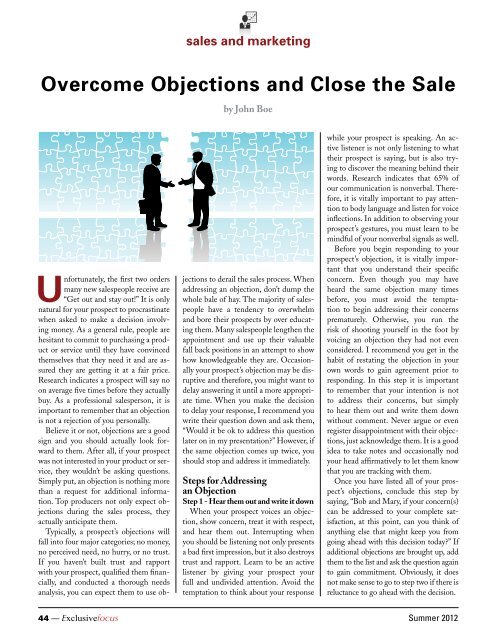sales and marketingOvercome Objections and Close the Saleby John BoeUnfortunately, the first two ordersmany new salespeople receive are“Get out and stay out!” It is onlynatural for your prospect to procrastinatewhen asked to make a decision involvingmoney. As a general rule, people arehesitant to commit to purchasing a productor service until they have convincedthemselves that they need it and are assuredthey are getting it at a fair price.Research indicates a prospect will say noon average five times before they actuallybuy. As a pr<strong>of</strong>essional salesperson, it isimportant to remember that an objectionis not a rejection <strong>of</strong> you personally.Believe it or not, objections are a goodsign and you should actually look forwardto them. After all, if your prospectwas not interested in your product or service,they wouldn’t be asking questions.Simply put, an objection is nothing morethan a request for additional information.Top producers not only expect objectionsduring the sales process, theyactually anticipate them.Typically, a prospect’s objections willfall into four major categories; no money,no perceived need, no hurry, or no trust.If you haven’t built trust and rapportwith your prospect, qualified them financially,and conducted a thorough needsanalysis, you can expect them to use objectionsto derail the sales process. Whenaddressing an objection, don’t dump thewhole bale <strong>of</strong> hay. The majority <strong>of</strong> salespeoplehave a tendency to overwhelmand bore their prospects by over educatingthem. Many salespeople lengthen theappointment and use up their valuablefall back positions in an attempt to showhow knowledgeable they are. Occasionallyyour prospect’s objection may be disruptiveand therefore, you might want todelay answering it until a more appropriatetime. When you make the decisionto delay your response, I recommend youwrite their question down and ask them,“Would it be ok to address this questionlater on in my presentation?” However, ifthe same objection comes up twice, youshould stop and address it immediately.Steps for Addressingan ObjectionStep 1 - Hear them out and write it downWhen your prospect voices an objection,show concern, treat it with respect,and hear them out. Interrupting whenyou should be listening not only presentsa bad first impression, but it also destroystrust and rapport. Learn to be an activelistener by giving your prospect yourfull and undivided attention. Avoid thetemptation to think about your responsewhile your prospect is speaking. An activelistener is not only listening to whattheir prospect is saying, but is also tryingto discover the meaning behind theirwords. Research indicates that 65% <strong>of</strong>our communication is nonverbal. Therefore,it is vitally important to pay attentionto body language and listen for voiceinflections. In addition to observing yourprospect’s gestures, you must learn to bemindful <strong>of</strong> your nonverbal signals as well.Before you begin responding to yourprospect’s objection, it is vitally importantthat you understand their specificconcern. Even though you may haveheard the same objection many timesbefore, you must avoid the temptationto begin addressing their concernsprematurely. Otherwise, you run therisk <strong>of</strong> shooting yourself in the foot byvoicing an objection they had not evenconsidered. I recommend you get in thehabit <strong>of</strong> restating the objection in yourown words to gain agreement prior toresponding. In this step it is importantto remember that your intention is notto address their concerns, but simplyto hear them out and write them downwithout comment. Never argue or evenregister disappointment with their objections,just acknowledge them. It is a goodidea to take notes and occasionally nodyour head affirmatively to let them knowthat you are tracking with them.Once you have listed all <strong>of</strong> your prospect’sobjections, conclude this step bysaying, “Bob and Mary, if your concern(s)can be addressed to your complete satisfaction,at this point, can you think <strong>of</strong>anything else that might keep you fromgoing ahead with this decision today?” Ifadditional objections are brought up, addthem to the list and ask the question againto gain commitment. Obviously, it doesnot make sense to go to step two if there isreluctance to go ahead with the decision.44 — <strong>Exclusivefocus</strong> <strong>Summer</strong> 2012
Step 2 - Feed it back for clarificationFeeding the objection back in the form<strong>of</strong> a question provides your prospect an opportunityto expand upon their concern.For example, if your prospect said theydon’t have the money in their budget, youwould simply feed it back in a nonjudgmentalway by saying; “You don’t have themoney in your budget?” This techniquegreatly reduces the perception <strong>of</strong> pressure.By giving your prospect the opportunity toexplain their statement, they will frequentlyanswer their own objection. Another goodreason to clarify the objection is to makecertain you are addressing their exact concernand not inadvertently creating a newone. Some objections are <strong>of</strong> greater importanceto your prospect than others. A prospectwill <strong>of</strong>ten use insignificant objectionsin an attempt to stall or delay the closingsequence. After you have clarified the objection,ask your prospect how importantthat concern is to them. After all, not everyobjection is really important.Step 3 - Answer the objection and“Touch Close” the SaleWhen addressing an objection try tostay big picture, but be prepared to providedetails upon request. Use graphs,charts, numbers, and/or testimonials ifthe big picture approach isn’t effective.During this important step, pay particularattention to your prospect’s bodylanguage gestures. Once your prospectagrees that their objection has been resolved,let them watch you cross it <strong>of</strong>fyour list. Continue this deliberate processuntil each and every objection hasbeen resolved. Complete this step byasking, “At this point can you think <strong>of</strong>anything else that might keep you fromgoing ahead with this purchase today?” Ifthey say no, proceed with confidence tothe final step and ask them for the order.Step 4 - Ask for the Orderand Expect a DecisionTransition into this step by saying,“Bob and Mary, am I correct in sayingthat it appears you both have convincedyourselves in the merits <strong>of</strong> this purchase?”If you sense the least bit <strong>of</strong> hesitation, excuseyourself by saying, “Bob and Mary,I can tell that you need a moment to discussthis information in private, so I amgoing to get a cup <strong>of</strong> c<strong>of</strong>fee and give youtime to make your decision.” This techniquedramatically reduces the likelihood<strong>of</strong> your prospect taking the informationhome to “think about it.” Keep in mindthat you may have to ask for the orderseveral times before you get the sale; somake sure to vary your closing questions.The key to overcoming objections andclosing the sale is to remain pr<strong>of</strong>essionaland be persistent without becoming argumentativeor defensive. Knowing howto effectively address your prospect’s objectionsbrings you closer to their finalquestion, “Where do I sign?” EfJohn Boe presents a wide variety <strong>of</strong> motivationaland sales-oriented keynotes andseminar programs for sales meetings andconventions. John is a nationally recognizedsales trainer and business motivationalspeaker with an impeccable track record inthe meeting industry. To learn more, visitwww.johnboe.com or call 937-299-9001.Free Newsletter available on website.Reporting “Questionable Business Practices” to AllstateNAPAA receives many inquires from agents who call to complain about unethical conduct by other agents. Itseems unethical behavior is becoming more commonplace, which is why it is up to the agency force to policeitself. And reporting bad behavior is easy and will help protect our rates. Following are selected excerpts fromthe www.AlertLine.com website, operated by Global Compliance, a third-party provider contracted by Allstate.“The Allstate i-Report process is designed to allow employees and non-employees to report potential compliance,unethical business practices and/or raise business issues.”“The Allstate i-Report Process is based on these principles:• Fairness: Every concern will receive individual consideration and be evaluated consistent with the commitment<strong>of</strong> Allstate to the employees.• Promptness: Concerns will be promptly directed to areas within the company that have the authority andresponsibility to review, investigate and resolve the issues.• Safety: Concerns can be voiced without fear <strong>of</strong> retaliation.• Confidentiality: Concerns will be kept confidential. Information will be disclosed only to those who needto know in order to review, investigate and respond to your concern.”“Global Compliance Services (“GCS”), pursuant to an agreement between its clients, provides a website tocollect from employees and others wishing to report information. This information includes but is not limited toallegations <strong>of</strong> misconduct, questionable business practices, violations <strong>of</strong> a company’s code <strong>of</strong> conduct or otherevents and behavior which may result in harm, injury or liability. The information collected and submitted is forwarded,without review or modification by GCS, to the client’s designated contacts.”To file a report, agents should go to www.AlertLine.com or call 800.427.9389.<strong>Summer</strong> 2012 <strong>Exclusivefocus</strong> — 45
















